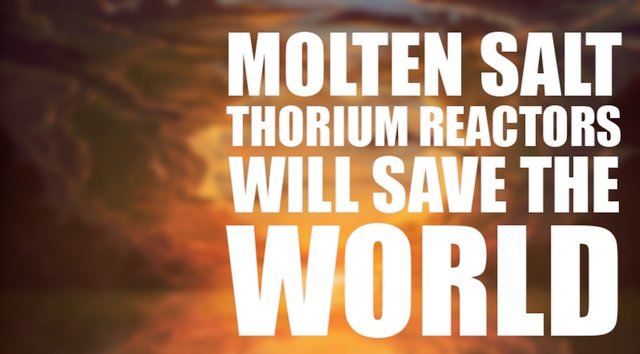
Nuclear is going to save the world.
This is not a sentence I thought I would utter just 6 years ago, when I was staunchly anti-nuclear and was looking into a design to increase the efficiency of photovoltaics.
I guess I'll get right into the meat of it.
Nuclear power is renewable or practically inexhaustible to the same extent solar power is, because the energy density of Uranium and Thorium are such that you can either constantly extract Uranium economically from seawater (which will be replaced by natural leeching from rocks and hydrothermal vents) or mine everyday rock for its Thorium energy content, and do this for hundreds of millions of years.
To drive home exactly how strongly renewable it is, the ocean extraction of U becomes impractical when the oceans begin to boil off in a billion years.


Okay, you're concerned about nuclear accidents like Fukushima, Chernobyl or Three Mile Island.
The fix is incredibly simple: use reactor types that literally cannot meltdown just like water cannot naturally flow up. Didn't know that can be a thing? It's a thing. Don't blame ya for not knowing about it, it's really not mentioned enough in popular media.
The problem from current comes from the coolant being water, being pressurized at a hundred atmospheres (think scuba tank) so if the super thick reactor vessel walls get dinged, the 350°C water inside flashes to steam. The solid fuel pellets inside, still generating all that heat, suddenly lost their heatsink. Oh shit, now it has melted. Oh, and the zirconium tubes that held the uranium pellets? That apparently reacts with the steam to produce hydrogen and oxygen gas that collects in the containment building. It'd be a shame if a spark lit that up.



If instead, you use a coolant that can be liquid at normal pressures, and continues to be liquid for a thousand degree range (like a type of salt) then suddenly you don't need to build a huuuge expensive pressure vessel, oh and said salt can't get split apart like water can (different kind of bonds, chemistry) so your coolant is always around.
You can go even further than that, and dissolve your nuclear fuel directly into the salt. Now when the salt mix heats up, it all expands just like warmer air or water do. More expansion, less chance of neutrons hitting other fissile atoms, and oh shit you just made a self-controlling reaction.
Pat yourself on the back. It's gonna get even better.
And cuz the coolant is all liquid even at 800°C you can run it at twice the temperature of a normal gas/coal boiler, or nuclear power reactor. Why is this important? You can now use different types of turbines that are 50% more efficient.
And that waste heat?
Still more than hot enough to desalinate ocean water for practically free.
Suddenly you don't even need to touch aquifers and rivers anymore.
You can raise and decrease power production way faster than the old nuclear before it. A type of reactor you can integrate in with solar and wind, and not have to use low efficiency fast startup open cycle gas turbine power plants (which by the way they tend to choose first as the backup generation.)
Or you could use the off-peak generation hours to produce carbon-neutral hydrocarbon fuels as direct replacements to fossil jet fuels, diesel and basically everything without using millions of acres of arable land that biofuels would require. And it would cost about $2 per gallon to produce.



The reactor type that can do all this is called the molten-salt reactor, sometimes simplified to the thorium reactor (by the way, solid fuel thorium reactors? ew.)
It is expected to produce electricity at about 3 cents per kWh. The cheapest natural gas is about 4 cents. And it could do this on demand, whenever, wherever, for the next hundred million years.



Yikes not so loud. Quick crash course in nuclear material and the reactors that use and generate 'em. First, the shorter the half-life an isotope has, the more radioactive it is, but it'll be gone sooner. A kilogram of something that has a half life of 1 year is scary as fuck, but will decay away to nothing within the century. Comparatively, something with a half-life of a billion years won't do a thing to you, unless it's chemically toxic in which case please refrain from licking the material.
It just so happens that with a molten-salt reactor you can keep the nuclear fuel simmering inside it without having to take it out early because of the nuclear waste build-up (96% of spent nuclear fuel rods? Actually nuclear fuel that can be burned again if the other stuff that has collected is filtered out) and as such you're not getting Plutonium building up cuz it gets busted apart. You can just keep it in there until it stops existing.
"Oh shit, does this mean we can take apart nuclear bombs and use these reactors to destroy Plutonium?"
Fuck yeah it does. And it produces carbon-free electricity at the same time.
So at the end of the day, the MSR produces 200 times more power per unit of fuel, 200 times less waste per watt generated, and would you look at that, 87% of that waste is stuff that's safe in under 10 years for resale (including fucking Palladium and Rhodium, go look up what a kilo of THAT costs) and the remaining 13% needs to be contained for a few hundred years before it's safe. But hey, a few hundred years? That's something we can THINK about. That's within human timescales. Lead casket storage underground for a bit? That's fine. Not fucking tens of thousands of years, god.
One minor rare-earths mine could supply the entire planet with all of its energy just from the Thorium waste byproduct of their operations.
5,300,000,000 tonnes of coal.
31,100,000,000 barrels of crude oil.
2,920,000,000,000 cubic metres of natural gas.
Shit, even 65,000 tonnes of Uranium ore.
All replaced by 6,600 tonnes of Thorium.
Put in different terms, the world's largest oil supertankers have roughly the same energy content when fully stocked, as a cube of Thorium metal roughly the size of a 10 litre box of spring water.



What things suddenly become economically feasible that weren't beforehand? Brute force incineration of all garbage, recycling their elements? Transitioning all farming to hydroponics in skyscrapers. Greening the deserts in a way that outclasses anything before. A triumphant return to a revitalized garden world with us as the stewards, not pillagers. We can use more energy without feeling guilty, by completely decoupling energy intensity from environmental destruction.
"Human civilization has changed over things far less major than this. -- When we learned how to make carbon our slave we started to learn how to be civilized people. Thorium has a million times the energy density of a carbon-hydrogen bond. What could that mean for human civilization going out hundreds, thousands of years?
Because we are never going to run out of the stuff. We will never run out.
It is simply too common."
-- Kirk Sorensen



Great post!
I've written about this as a very worthy goal for the Billion Heros Game
Downvoting a post can decrease pending rewards and make it less visible. Common reasons:
Submit
good post!
Downvoting a post can decrease pending rewards and make it less visible. Common reasons:
Submit
Really informative, I hardly knew any of this. If the salt reactors are so safe and efficient why haven't we built more?
Downvoting a post can decrease pending rewards and make it less visible. Common reasons:
Submit
There's some remarkably rich history behind the reason why. Eugene Wigner, one of the early players in nuclear energy development got one of his studens, Alvin Weinberg interested in using Thorium as a nuclear fuel (while Enrico Fermi and the other lot went off for Plutonium)
In the late 50s Weinberg and co. found there was a funding opportunity for experimental reactor research from the US Air Force for a flying bomber. They thought, "nuclear powered bomber... that's really fucking dumb" but hey free money. In the process of that they had to make something that was so simple, so stable, so light that it could fit into a plane that could fly. So that meant atmospheric pressure operation with a coolant that doesn't wanna bounce on you. This was called the Aircraft Reactor Experiment and was the first demo of a type of molten salt reactor, ran at like almost 900 degrees Celsius and all that stuff.
Well, with the success of the ARE, Weinberg badgered the brass to get standalone funding for a design they slapped together and ended up working great. They got it, and the Molten Salt Reactor Experiment was born. They built it with fuck all funding and despite that, it worked exactly as they calculated as it ought to do, and ran for thousands of hours continuously, stable at some of the highest temperatures ever obtained by a nuclear fission reactor. There's even a part of the MSRE history where one of their probes dropped into the active molten fuel salt and they had to go fishing with a long pole and some fibre optics and nothing bad happened lol. Try losing a foreign metallic object in a pressurized solid fuel reactor lol.
Aaaanyway. At the end of the research part of the MSRE in the early 70s the people there were pretty chuffed about what they had accomplished, so Alvin Weinberg went to the Atomic Energy Commission to request more funding to make a full-scale commercial model. However a number of conspiring things occured so this did not happen. The golden child worshipped by the AEC was the Plutonium-fueled Liquid Metal Fast Breeder Reactor which had been favored from the outset by the US Government simply because there was more pre-existing experience with Plutonium at the time, and it didn't help that Weinberg was almost indirectly insulting the intelligence of much of the AEC, including Admiral Rickover who headed the Nautilus nuclear submarine project, by suggesting that light water reactors were not suited to civilian power generation, citing loss of coolant, containment and spreading of radionuclides into the environment. Weinberg happened to be one of the inventors of the light water reactor. Ouch. And to add on top of all this, the MSRE was in Tennessee, the LMFBR was in California, and Nixon wanted a jobs project to show to his home state. And so, the MSRE not only didn't get it's expansion funding, but was phased out entirely. And the only people who knew about it were maybe a few hundred in the area around Oak Ridge, and the idea faded for decades.
"Well, why didn't private industry take up the torch?" -- Westinghouse, GE and the like operate on a razor blades business model. They'll sell you the reactor pretty much at cost, but make their money back by locking you into a multi-decade Uranium pellet fuel contract. A reactor that costs little with the fuel being practically free doesn't fit in well to their business model. Not to mention it takes an inordinate amount of time and money to get a new design licensed commercially with the US NRC and no private company is going to willingly sit blue-balled while that happens and they have stockholders tapping their foot impatiently.
Thankfully there are many start-ups that are going the MSR route these days, not to mention the Chinese TMSR project. I'm mostly hyped about ThorCon which plan to make Thorium-fueled MSRs in Indonesian shipyards and export them globally by the early 2020s, led by one of the dudes in charge of building those huge Hellespont supertankers and shipping barges, and then there's Terrestrial Energy which is in the later stages of applying for a billion dollar grant from the US DoE for a commercialized version of a (Uranium fueled) MSR which they will then certify in Canada where the regulatory structure is a lot saner.
Downvoting a post can decrease pending rewards and make it less visible. Common reasons:
Submit
I guess I'm not surprised that bureaucracy and politics are to blame, as usual, but it's cool that it seems these things will be implemented sooner than later. Thanks for all the info and links, very interesting and informative!
Downvoting a post can decrease pending rewards and make it less visible. Common reasons:
Submit
For those interested in going deeper into background, technical detail, and references about molten salt thorium reactors (and other kinds of molten salt reactors) check out the World Nuclear Association's Molten Salt Reactors article.
Downvoting a post can decrease pending rewards and make it less visible. Common reasons:
Submit
Good job
Downvoting a post can decrease pending rewards and make it less visible. Common reasons:
Submit